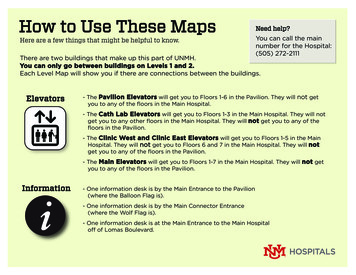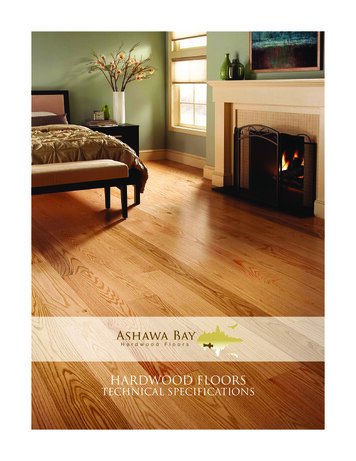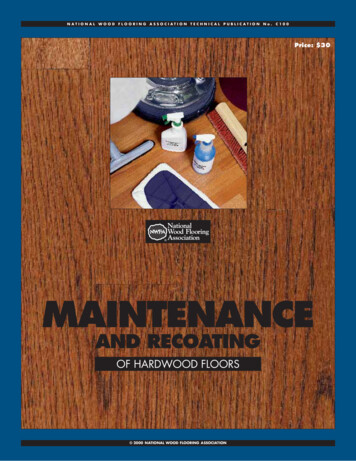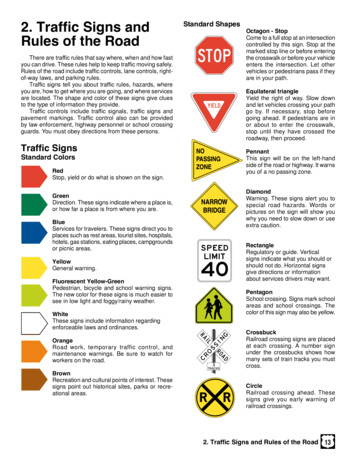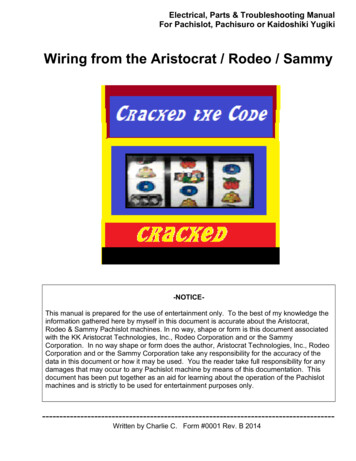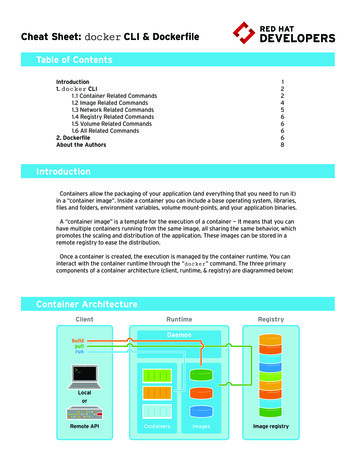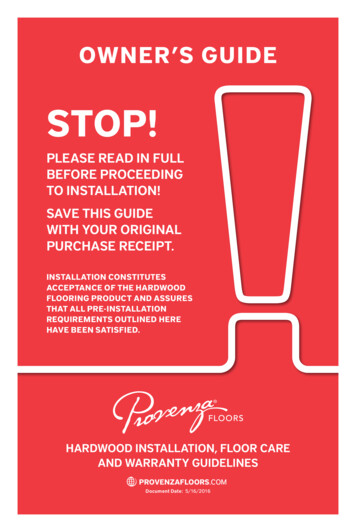
Transcription
OWNER’S GUIDESTOP!PLEASE READ IN FULLBEFORE PROCEEDINGTO INSTALLATION!SAVE THIS GUIDEWITH YOUR ORIGINALPURCHASE RECEIPT.INSTALLATION CONSTITUTESACCEPTANCE OF THE HARDWOODFLOORING PRODUCT AND ASSURESTHAT ALL PRE-INSTALLATIONREQUIREMENTS OUTLINED HEREHAVE BEEN SATISFIED.HARDWOOD INSTALLATION, FLOOR CAREAND WARRANTY GUIDELINESPROVENZAFLOORS.COMDocument Date: 5/16/2016Provenza-HardwoodGuidelines Booklet 05-16-2016.indd 15/16/2016 2:43:25 PM
Provenza-HardwoodGuidelines Booklet 05-16-2016.indd 25/16/2016 2:43:25 PM
THANK YOU for your Provenza hardwood flooring purchase. At Provenza Floors , Inc. everyhardwood collection we create is a reflection of our company and the artisans whocarefully craft each piece so no two planks are ever alike.Our hardwood floor collections are both beautiful, durable and backed by industrystandard warranty coverage. With proper pre-installation testing and preparation,expert installation, floor care and maintenance, your new Provenza hardwood floorwill give you years of beauty and function.PLEASE READ THESE INSTRUCTIONS INSTRUCTIONS IN FULL BEFORE PROCEEDING TO INSTALLATION!INSTALLATION CONSTITUTES ACCEPTANCE OF THE HARDWOOD FLOORINGPRODUCT AND ASSURES THAT ALL PRE-INSTALLATION REQUIREMENTS OUTLINED HERE HAVE BEEN SATISFIED.Additional hardwood flooring technical resources are available through the NationalWood Flooring Association at its website at: nwfa.orgIf you ever have questions regarding your Provenza hardwood flooring purchase,proper installation procedures, floor care and maintenance or warranty coverage,call Provenza’s Product Support, toll free at (877) 455-7890.PROVENZAFLOORS.COMCorporate Office: 1 (877) 455-7890Provenza-HardwoodGuidelines Booklet 05-16-2016.indd 35/16/2016 2:43:25 PM
Provenza-HardwoodGuidelines Booklet 05-16-2016.indd 45/16/2016 2:43:25 PM
CONTENTSBEFORE YOUR FLOORING ARRIVES . Page 5Jobsite Conditions . Page 5Subfloor Conditions . Page 5Acceptable Subfloor Types . Page 6Subfloor Moisture Testing Requirements . Page 6Ambient Temperature Requirements . Page 7ONCE YOUR FLOORING ARRIVES . Page 7Product Inspection and Acceptance . Page 7Handling and Storage . Page 7Acclimation Process . Page 8INSTALLATION . Page 9Preparing for Installation . Page 9Starting Installation . Page 9Glue Down Installation Method . Page 10Staple or Nail Installation Method . Page 11Floating Installation Method . Page 12Installation Over Radiant Heat . Page 13Protection During Construction or Remodeling . Page 16GENERAL FLOOR CARE & MAINTENANCE . Page 17UV Acrylic / Polyurethane Finish Care & Maintenance . Page 18Oil Finish Care & Maintenance . Page 18RESIDENTIAL WARRANTY . Page 21COMMERCIAL WARRANTY . Page 23CUSTOMER SERVICE . Page 25Internet Sales Policy . Page 25Claims Process . Page 25Save Your Original Receipt! . Page 25Owner/Installater Notes . Page 26PROVENZAFLOORS.COMCorporate Office: 1 (877) 455-7890Provenza-HardwoodGuidelines Booklet 05-16-2016.indd 55/16/2016 2:43:25 PM
BEFORE YOUR FLOORING ARRIVESProvenza hardwood flooring is an investment that with proper jobsite preparationwill lead to a successful installation.Your expert installer should evaluate the jobsite before the Provenza hardwood flooring is delivered. This includes detecting and correcting possible jobsite and subfloorissues that might affect the hardwood flooring once it is delivered and installed.Provenza also recommends that the Owner remove valuables from the installationarea, including but not limited to, artwork mounted on walls, fragile decorations,and other personal items. Provenza Floors , Inc. is not liable for losses and damages, accidental or otherwise, caused by the Installer and/or sub-contractors.The Provenza Floors manufacturer warranty does not cover flooring failures resulting from a failure to perform required pre-installation and installation procedures,including but not limited to, Owner/Purchaser/Installer negligence, accidental orotherwise.Jobsite ConditionsOwner/Purchaser and Installer are responsible for ensuring that exterior grading iscomplete with surface drainage offering a minimum drop of 3" in 10' to direct exterior water sources away from the structure where the flooring will be installed.Owner and Installer should ensure that the “grade” where the hardwood flooring willbe installed is appropriate for its construction: Provenza engineered hardwood floors are approved for below, on-grade, abovegrade installation. Below-grade installations require a floating installation method. Provenza solid hardwood floors are approved for on-grade and above-grade installations and should not be installed in below-grade areas such as basements.The jobsite should be enclosed and climate-controlled. HVAC systems must befully operational with a consistent room temperature of 65 - 85 F and relative humidity levels of 35%-55% before the flooring is delivered or installed.Provenza hardwood floors are not recommended for use in areas subject to repeated moisture exposure and possible water overflow areas such as bathrooms orlaundry rooms.To eliminate potential trade-related damage, Provenza recommends that its hardwood flooring be one of the last jobs completed. Drywall taping, wall painting andother “wet” work should be completed and thoroughly dry prior to installation.Subfloor ConditionsThe quality and preparation of the subfloor is critical to the proper installation ofProvenza hardwood flooring.Subfloors must be structurally sound, clean and free of all debris, staples, nails,wax, grease, paint, sealers, old adhesives and other substances that may preventa successful installation. Subfloors should be level and flat to 3/16" per 10' andmust remain dry all year round. Subfloor moisture content must not exceed 3.5%for Concrete or 13% for Wood, Plywood or OSB/Particleboard.5Provenza-HardwoodGuidelines Booklet 05-16-2016.indd 65/16/2016 2:43:25 PM
Acceptable Subfloor Types CDX Plywood Concrete - With a minimum compression strength of 3000 PSI. OSB/Particleboard - Must be structurally sound. Floating installation only.Wood subfloor must be: Clean, dry and well secured. Nailed or screwed down every 6 inches along the joists to remove squeaking. Leveled with high spots sanded down and low spots filled with a leveling compound. Leveling material should provide a structurally sound wood subfloor.Concrete subfloor must be: Clean and free of paint, sealers, adhesives or other debris. If present, concretesealer must be removed by grinding and sanding. Fully cured for at least 60 to 90 days prior to installation. Installed properly with minimum 6-mil poly film moisture barrier between concrete and ground. Dry all year round. Do not install hardwood flooring over concrete if it will not remain dry at all times.Subfloor Moisture Testing RequirementsMoisture testing of the jobsite and subfloors is critical to a successful hardwoodflooring installation. Visual checks are not reliable.If subfloor moisture exceeds acceptable levels, the source(s) of this moisture mustbe corrected before the hardwood flooring is delivered to the jobsite.Excess moisture detected in the subfloor requires the use of a moisture barrierproduct, including but not limited to, PVC vinyl sheet (with felt-backed and vinylwear layer) or, for concrete subfloors, a moisture retardant product that is approvedas a concrete sealant for use in hardwood flooring installation.Acceptable subfloor moisture testing methods include: Calcium Chloride Test. The maximum moisture transfer must not exceed3lbs/1000 square feet with this test. Tramex Concrete Moisture Encounter Meter. Moisture reading should not exceed4.5 on the upper scale. Relative Humidity Probe Test. Maximum moisture reading is 75%.Concrete Subfloor Test Method UsedCalcium Chloride (ASTM F1869)RH (ASTM F2170-02) 1869Electronic Meter (Tramex or equivalent)Concrete Subfloor Moisture Reading% Moisture Content of Concrete SubfloorA “DRY” SLAB, AS DEFINED BY THESE TESTS CAN STILL BECOME WET ATOTHER TIMES OF THE YEAR. THESE TESTS DO NOT GUARANTEE A DRYSLAB. ALL CONCRETE SLABS SHOULD HAVE A MINIMUM OF 6-MIL POLYFILM MOISTURE BARRIERS BETWEEN THE GROUND AND THE CONCRETE.6Provenza-HardwoodGuidelines Booklet 05-16-2016.indd 75/16/2016 2:43:25 PM
Wood Subfloor Moisture Content% Moisture Content of Wood SubfloorAmbient Temperature RequirementsThe jobsite should be evaluated for a consistent room temperature of 65 - 85 Fwith relative humidity levels of 35%-55%. These levels must be maintained, before, during and after installation for the life of the installed hardwood flooring.Flooring failures that are a consequence of not maintaining required ambient temperature levels, at all times, are not covered by the manufacturer warranty.ONCE YOUR FLOORING ARRIVESImportant steps must be taken prior to installation and is the responsibility of theOwner/Purchaser & Installer. These steps include, but are not limited to, productinspection and acceptance; proper handling and storage of the flooring/flooring cartons on-site; hardwood floor acclimation; individual plank inspection/selection andcarton blending with aesthetic attention given to character, grade, color and millingvariation, and with sufficient quantity on hand to complete the job.Provenza hardwood floors are a product of nature with naturally occurring imperfections in line with an industry accepted rate of approximately 5% of the totalflooring purchased, including but not limited to, finish imperfections, grading andcolor variations, milling and general cutting waste. Individual planks may also beaffected by die lot variations due to the staining process.Product Inspection and AcceptanceIt is the responsibility of the Owner/Purchaser & Installer to verify that the flooringdelivered is what is expected by the Owner/Purchaser before proceeding to installation. This can be accomplished by randomly inspecting boards from 2-3 differentcartons.DO NOT PROCEED TO INSTALLATION if the flooring product is not what wasexpected by the Owner/Purchaser. Do not continue opening cartons and do notdiscard cartons that were opened during inspection. Immediately notify theProvenza retailer where the flooring was purchased that there is a problem withyour flooring delivery!During the installation process, the Owner/Purchaser & Installer should inspectand approve each piece that will be used in the flooring installation. The Installermust use reasonable selectivity and hold out or cut off pieces with defects that fallwithin manufacturing tolerance levels, whatever the cause.Provenza Floors , Inc. cannot honor claims due to a lack of on-site hardwood flooring inspection and acceptance by the Owner/Purchaser & Installer.Provenza Floors , Inc. will not accept responsibility for the installation of hardwoodflooring with visible manufacturing defects.Handling and StorageOnce Provenza flooring is delivered to the jobsite, inspected and accepted by theOwner/Purchaser & Installer, the flooring cartons should be stored on a dry, flat7Provenza-HardwoodGuidelines Booklet 05-16-2016.indd 85/16/2016 2:43:25 PM
surface with good air circulation in the area where it will be installed. Removeplastic shipping wrap and keep cartons closed. When moving or handling cartonscare should be taken to prevent damage to the hardwood flooring inside.Do not store cartons directly on concrete, in garages, basements, near outsidewalls or in areas where the temperature is uncontrolled. Damage caused by the improper storage and handling of the hardwood flooring product is not covered by themanufacturer warranty.Acclimation ProcessWood flooring needs to reach a “moisture content equilibrium” with the surrounding environment where it will be installed. The process of reaching equilibrium isreferred to as “acclimation”. Proper acclimation ensures that the wood flooring hasadjusted to the area where it will be installed before installation begins: Always store cartons on a flat, dry surface in the area where they will be installed. Do not open cartons until the day of installation and protect from moisture. Jobsite must have a consistent room temperature of 65 - 85 F. Jobsite must have relative humidity levels of 35%-55% before, during and afterinstallation. WMC must be within 4% of the subfloor before starting installation.Flooring cartons must be placed in the area where they will be installed and allowed to acclimate for a minimum of 5 days.Remove plastic wrap from flooring cartons if present, but do not open the flooring cartons or take out individual planks until acclimation has been achievedand the flooring is ready to be installed. Proper consistent temperature and humidity levels in the installation area is key to the acclimation process.The required room temperature and humidity levels must be maintained for thelife of the hardwood floor installation.Once acclimation has been completed, the Installer should evaluate and record themoisture content of the hardwood flooring in relation to the subfloor.Acclimation Moisture Readings% Moisture Content of Subfloor% Moisture Content of Hardwood% Difference between Subfloor & HardwoodThe Installer should document that all pre-installation requirements have been metbefore proceeding to installation, including but not limited to, moisture testing andrecording testing results using photos with location, date, time and initials of theInstaller on each area of subfloor evaluated. The Owner should retain this documentation with this guide for future reference.The National Wood Flooring Association (nwfa.org) provides a “Jobsite Checklist” tohelp with this task. (NWFA Installation Guidelines, Section IV, Appendix M)8Provenza-HardwoodGuidelines Booklet 05-16-2016.indd 95/16/2016 2:43:25 PM
INSTALLATIONINSTALLATION CONSTITUTES ACCEPTANCE of the hardwood flooring productand assures that all pre-installation requirements outlined here have been satisfied.Installation is the responsibility of the Owner/Purchaser & Installer. Only an experienced, certified hardwood floor installer should perform your Provenza hardwoodfloor installation. NWFA Certified Hardwood flooring installers normally provide aperiod of warranty of their installation work. Installation related failures are notcovered by the manufacturer warranty.For best results, Provenza recommends that its hardwood flooring is installed by aNational Wood Flooring Association (NWFA) Certified Professional: nwfa.orgPreparing for InstallationFor aesthetic purposes, hardwood flooring is often laid to the longest wall. However, the Owner/Purchaser, in consultation with the Installer should make the finaldecision which direction the planks will run before proceeding to installation.Provenza also recommends staggering plank end joints during installation toachieve an overall random appearance, but, other patterns can be employed if sodesired by the Owner/Purchaser and is the responsibility of the Installer.IMPORTANT! The Installer should blend planks from different cartons to ensure anaesthetically pleasing color and shade mixture throughout the installation area.Starting InstallationThe tools generally needed for installation are: Handsaw or power saw, hammer,crowbar or pull bar, tape measure, pencil, chalk line, wood or plastic spacers, tapping block, carpenters square, adhesive trowel and a quality adhesive approved forhardwood flooring.Installation should begin next to an outside wall, as it is usually the straightest walland used as a reference point in establishing a straight working line. A good way toestablish a working line is to measure an equal distance from the wall at both endsand snapping a chalk line.Undercut or notch-out door casings to fit flooring thickness by placing a piece offlooring on the subfloor as a height guide for sawing. Remove door thresholds andbase moldings and replace after flooring installation. Always leave at least ½” expansion space between flooring and all walls and vertical objects.Measure the distance from the wall at the width of the plank plus another ½" foran expansion space when establishing your working line. It is advisable to dry lay afew rows before proceeding installation to confirm your directional layout decisionand working line. Adjustment of the working line may be necessary if the outsidewall or other working line reference is out of square. This can be done by scribecutting the first row of planks to match the wall, creating a straight working line.IMPORTANT! Adhesive/glue that comes in contact with the surface of oil finishedfloors will damage the finish. The use of adhesive/glue removal products on oil finishfloors, including but not limited to, acetone and paint thinner, will damage the finish.Provenza Floors , Inc. will not be liable for damages that are the result of a failure toprevent adhesive/glue exposure or the use adhesive/glue removal products.9Provenza-HardwoodGuidelines Booklet 05-16-2016.indd 105/16/2016 2:43:25 PM
Glue Down Installation MethodAll required pre-installation testing and preparation must be completed before proceeding. If moisture problems were detected during the pre-installation phase, amoisture barrier should be in place.Acceptable Subfloors CDX Plywood Concrete – With a minimum compressive strength of 3000 PSI.Adhesive RequirementsOnly a moisture cured polyurethane adhesive approved for hardwood floor installation is acceptable. The use of a cheaper flooring adhesive or other brands of gluenot approved for use with hardwood flooring will lead to flooring failure and voidthe manufacturer warranty.Follow the instructions for the hardwood flooring adhesive carefully. Allow for adequate cross ventilation when working with flooring adhesive. Allow proper set time before affixing the hardwood floor planks. Use the adhesive manufacturer recommended spreading trowel. Spread adhesive per the flooring adhesive instructions.Using a trowel held at a 45 angle, spread hardwood flooring adhesive as recommended by the adhesive manufacturer, starting at the outside wall.Once adhesive has set, lay the first row of flooring with the groove facing the wall.Use a hammer and tapping block to tap against the tongue side to pull planks together. When near a wall, use a crow or pull bar to close end joints.Never tap against the groove side or the end joints of the plank as doing so willdamage the flooring finish and void the manufacturer warranty.IMPORTANT! Adhesive/masking tape applied directly to hardwood floor surfacewill damage the factory finish and void the manufacturer warranty.Use wood wedges at walls to maintain the required ½" expansion space from thehardwood flooring plank.To ensure that plank end joints are not too close to each other in adjacent rows, itis best to rack out 3 to 4 rows as installation proceeds. Allow a minimum of 10" to12" between end joints in adjacent rows.When the first section is completed, continue by repeating the process, checkingplank alignment with the working line, section by section until installation is complete.Be careful not to shift the installed floor on the wet adhesive. If needed, weightscan be used to hold flooring planks in place at the perimeter until the adhesivecures.As each plank is laid, check for and remove excess flooring adhesive or spills immediately. Failure to remove excess flooring adhesive or spills from the flooringsurface will damage the factory finish and void the manufacturer warranty.When wiping up excess T&G glue or spills, use a dry or damp soft cloth. Do notuse paint thinner or harsh adhesive-removing chemicals on the hardwood flooring10Provenza-HardwoodGuidelines Booklet 05-16-2016.indd 115/16/2016 2:43:26 PM
surface as doing so will damage the finish and void the manufacturer warranty.As installation proceeds, cut the last plank in each row allowing for the required ½”expansion space. Use a crow or pull bar to install the last plank ensuring a tight fit.Leave the ½" expansion wedges in place until the flooring adhesive is fully dry.Do not allow foot traffic for at least 8 hours and allow a minimum of 24 hours before heavy furniture is moved onto the hardwood flooring.Finishing the JobRemove the ½" expansion spacers from the perimeter. Install or reinstall base and/or quarter round moldings to cover the expansion space. Install transition piecessuch as reducer strips and T-moldings as needed.Clean and remove all dirt and debris from your new floor by dry dust mopping. Follow “Floor Care and Maintenance” instructions to ensure the longevity and lastingbeauty of your new Provenza Hardwood Floor.Staple or Nail Installation MethodAll required pre-installation testing and preparation must be completed before proceeding. If moisture problems were detected during the pre-installation phase, amoisture barrier should be in place.Acceptable Subfloor Type A minimum of 5/8" CDX PlywoodUnderlayment Recommendation FeltStaple or nail installation may be successful over existing vinyl provided: That the subfloor is properly attached to the joists and in good condition. That the subfloor is not particleboard or OSB or Particleboard That the staple or nail penetration is not significantly lessened due to thickness of existing vinyl.The recommended length for the staple or nail is 1½" with a spacing of 4" – 6"along the length of the plank and 1" from each end.Use wood wedges at walls or obstructions to maintain the required ½” expansionspace from the hardwood flooring plank.Staple or nail the first row of flooring with the groove facing the starting wall stapling or nailing in 4 to 6-inch spacing increments. Using a quality T&G glue product, glue the joint ends of each plank for added strength, and then, use a tappingblock to ensure a tight bond between planks.As each plank is stapled or nailed, check for and remove excess T&G glue orspills immediately. Failure to remove excess T&G glue or spills from the flooringsurface will damage the factory finish and void the manufacturer warranty.IMPORTANT! Any plank damaged by the process of stapling or nailing, should bepulled up and replaced with a new plank before proceeding. Flooring damaged during the staple or nail installation process is not covered by the manufacturer warranty.11Provenza-HardwoodGuidelines Booklet 05-16-2016.indd 125/16/2016 2:43:26 PM
To ensure that plank end joints are not too close to each other in adjacent rows, itis best to rack out 3 to 4 rows as installation proceeds. Allow a minimum of 10" to12" between end joints in adjacent rows.When the first section is completed, continue by repeating the process, checkingplank alignment with the working line, section by section until installation is complete.When wiping up excess T&G glue or spills, use a dry or slightly damp soft cloth. Donot use paint thinner or harsh adhesive-removing chemicals on the hardwood flooring surface as doing so will damage the finish and void the manufacturer warranty.As installation proceeds, cut the last plank in each row allowing for the required ½”expansion space. Use a crow or pull bar to install the last plank ensuring a tight fit.IMPORTANT! Adhesive/masking tape applied directly to hardwood floor surfacewill damage the factory finish and void the manufacturer warranty.Finishing the JobRemove ½" expansion spacers from the perimeter. Install or reinstall base and/orquarter round moldings to cover the expansion space. Install transition pieces suchas reducer strips and T-moldings as needed.Clean and remove all dirt and debris from your new floor by dry dust mopping. Follow “Floor Care and Maintenance” instructions to ensure the longevity and lastingbeauty of your new Provenza Hardwood Floor.Floating Installation MethodAll required pre-installation testing and preparation must be completed before proceeding. If moisture problems were detected during the pre-installation phase, amoisture barrier should be in place.Acceptable Subfloors CDX Plywood Concrete – With a minimum compressive strength of 3000 PSI. OSB/Particleboard – Must be structurally sound.Underlayment Recommendations Rubber CorkBegin laying the first row of flooring with the groove side facing the starting wall.Use a hammer and tapping block to tap against the tongue side to pull planks together to ensure a tight fit. When near a wall, use a crow or pull bar to close endjoints.Never tap against the groove side or the end joints of the plank as doing so willdamage the flooring finish and void the manufacturer warranty.Use wood wedges at walls or obstructions to maintain the required ½" expansionspace from the hardwood flooring plank.To ensure that plank end joints are not too close to each other in adjacent rows, itis best to rack out 3 to 4 rows as installation proceeds. Allow a minimum of 10" to12" between end joints in adjacent rows.12Provenza-HardwoodGuidelines Booklet 05-16-2016.indd 135/16/2016 2:43:26 PM
Apply a quality T&G glue in the top portion of the groove along the side and endjoints of each plank to ensure a strong bond between them.As each plank is installed, check for and remove excess T&G glue or spills immediately. Failure to remove excess T&G glue or spills from the flooring surface willdamage the flooring finish and void the manufacturer warranty.When wiping up excess T&G glue or spills, use a dry or damp soft cloth. Do notuse paint thinner or harsh adhesive-removing chemicals on the hardwood flooringsurface as doing so will damage the finish and void the manufacturer warranty.As installation proceeds, cut the last plank in each row allowing for the required ½"expansion space. Use a crow or pull bar to install the last plank ensuring a tight fit.IMPORTANT! Adhesive/masking tape applied directly to hardwood floor surfacewill damage the factory finish and void the manufacturer warranty.Leave expansion space wedges in place for a minimum of 8 hours to allow the T&Gglue to fully dry.Do not allow foot traffic for a minimum of 8 hours and allow a minimum of 24hours before heavy furniture is moved onto the hardwood flooring.Finishing the JobRemove the ½" expansion spacers from the perimeter. Install or reinstall base and/or quarter round moldings to cover the expansion space. Install transition piecessuch as reducer strips and T-moldings as needed.Clean and remove all dirt and debris from your new floor by dry dust mopping. Follow “Floor Care and Maintenance” instructions to ensure the longevity and lastingbeauty of your new Provenza Hardwood Floor.INSTALLATION OVER RADIANT HEATAll required pre-installation testing and preparation must be completed before proceeding. If moisture problems were detected during the pre-installation phase, anapproved moisture barrier must be in place.Flooring failures due to improperly installed hydronic radiant heat systems arenot covered by the Provenza manufacturer warranty.It is the Owner/Purchaser & Installer’s responsibility to ensure that the hydronicradiant heat system is installed per the radiant heat manufacturer instructions andoperating properly before proceeding to the hardwood floor installation.Approved Provenza Hardwood Flooring Engineered oak products only.Approved Radiant Heat Type Hydronic radiant heat systems only.Installation Method Floating installation method only.Acceptable Subfloors CDX Plywood Concrete – With a minimum compressive strength of 3000 PSI.13Provenza-HardwoodGuidelines Booklet 05-16-2016.indd 145/16/2016 2:43:26 PM
Underlayment Recommendation CorkApproved Hydronic Radiant Subfloor Systems Aluminum Hangers Channel Aluminum Board Sleeper Systems Lightweight Thermal Mass Concrete with min 3000 PSI compressive strength 1 1/8" T&G WarmboardHeating Control RequirementsRadiant heat installations must have a heat control system that helps maintain aconstant baseline temperature and prevents overheating. Radiant heat temperatures that exceed 85 degrees will damage the hardwood flooring and void themanufacturer warranty.Provenza requires that an exterior thermostat be installed and working at all times.Unlike conventional heating systems which switch on as needed, radiant systemswork most effectively with hardwood flooring if the heating process is gradual withsmall, incremental increases in relation to outside temperature.Radiant Heating System Acclimation ProcessThe hydronic radiant heating system must be operational and heated for at least 7days prior to the installation of Provenza engineered oak f
Provenza hardwood floors are not recommended for use in areas subject to re-peated moisture exposure and possible water overflow areas such as bathrooms or laundry rooms. To eliminate potential trade-related damage, Provenza recommends that its hard-wood flooring be one of the last jobs completed. Drywall taping, wall painting and
